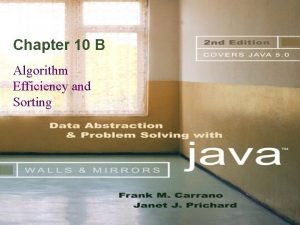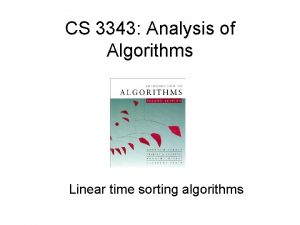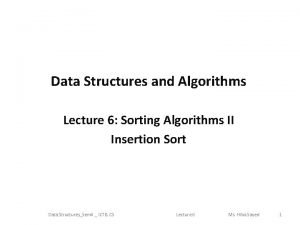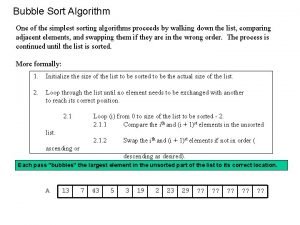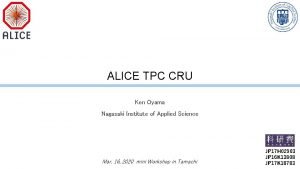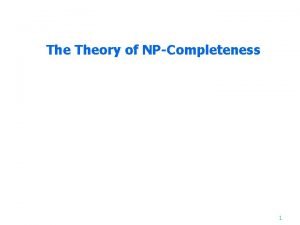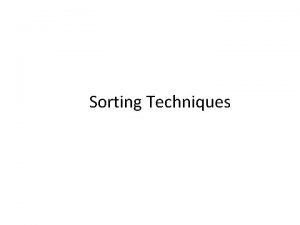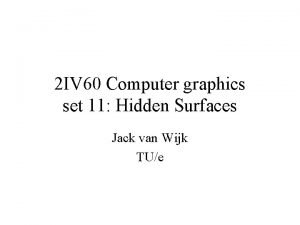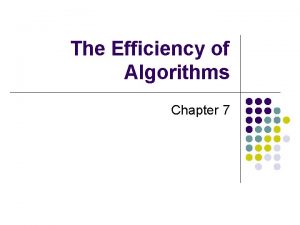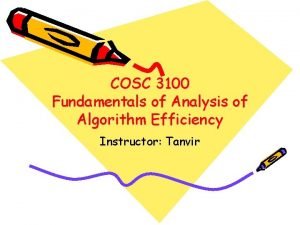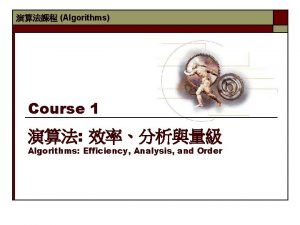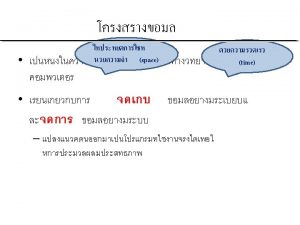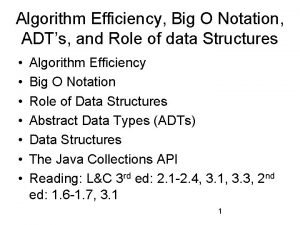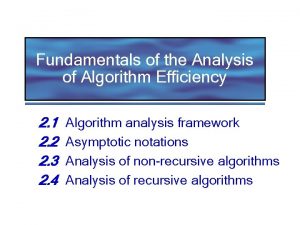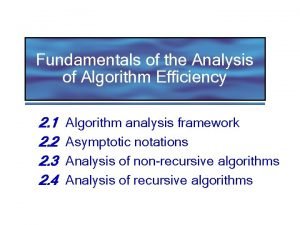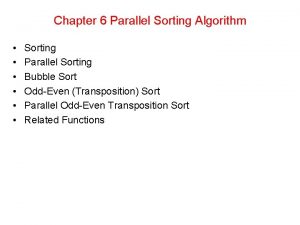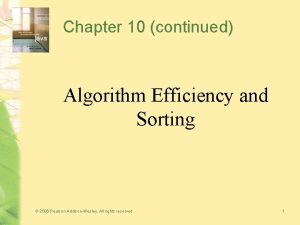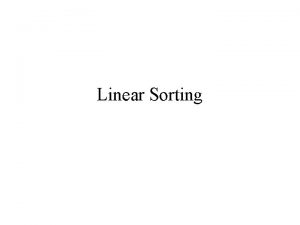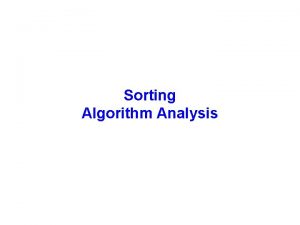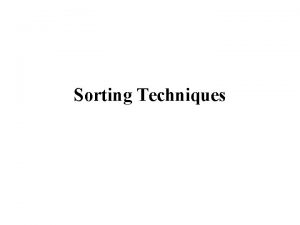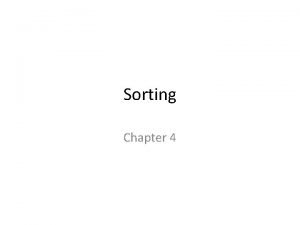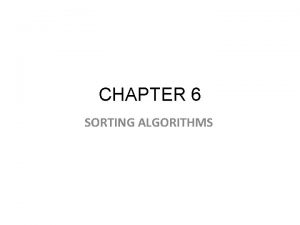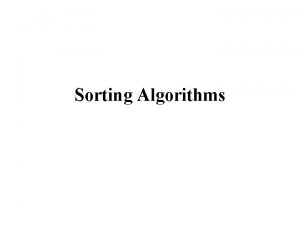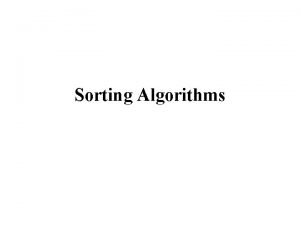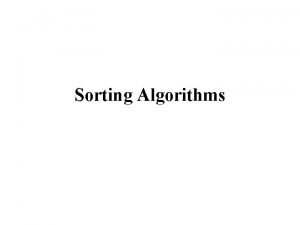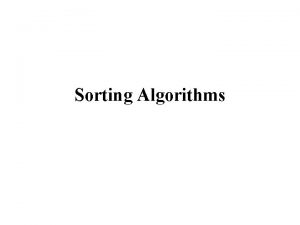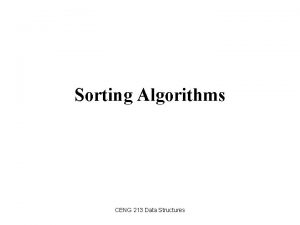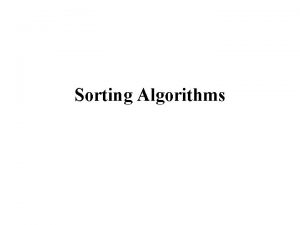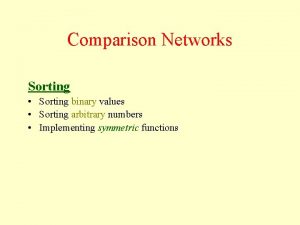Chapter 10 continued Algorithm Efficiency and Sorting 2011





















- Slides: 21

Chapter 10 (continued) Algorithm Efficiency and Sorting © 2011 Pearson Addison-Wesley. All rights reserved 10 B-1

Bubble Sort • Bubble sort – Strategy • Compare adjacent elements and exchange them if they are out of order – Comparing the first two elements, the second and third elements, and so on, will move the largest (or smallest) elements to the end of the array – Repeating this process will eventually sort the array into ascending (or descending) order © 2011 Pearson Addison-Wesley. All rights reserved 10 B-2

Bubble Sort Figure 10 -5 The first two passes of a bubble sort of an array of five integers: a) pass 1; b) pass 2 © 2011 Pearson Addison-Wesley. All rights reserved 10 B-3

Bubble Sort • Analysis – Worst case: O(n 2) – Best case: O(n) © 2011 Pearson Addison-Wesley. All rights reserved 10 B-4

Insertion Sort • Insertion sort – Strategy • Partition the array into two regions: sorted and unsorted • Take each item from the unsorted region and insert it into its correct order in the sorted region Figure 10 -6 An insertion sort partitions the array into two regions © 2011 Pearson Addison-Wesley. All rights reserved 10 B-5

Insertion Sort Figure 10 -7 An insertion sort of an array of five integers. © 2011 Pearson Addison-Wesley. All rights reserved 10 B-6

Insertion Sort • Analysis – Worst case: O(n 2) – For small arrays • Insertion sort is appropriate due to its simplicity – For large arrays • Insertion sort is prohibitively inefficient © 2011 Pearson Addison-Wesley. All rights reserved 10 B-7

Mergesort • Important divide-and-conquer sorting algorithms – Mergesort – Quicksort • Mergesort – A recursive sorting algorithm – Gives the same performance, regardless of the initial order of the array items – Strategy • Divide an array into halves • Sort each half • Merge the sorted halves into one sorted array © 2011 Pearson Addison-Wesley. All rights reserved 10 B-8

Mergesort Figure 10 -8 A mergesort with an auxiliary temporary array © 2011 Pearson Addison-Wesley. All rights reserved 10 B-9

Mergesort Figure 10 -9 A mergesort of an array of six integers © 2011 Pearson Addison-Wesley. All rights reserved 10 B-10

Mergesort • Analysis – Worst case: O(n * log 2 n) – Average case: O(n * log 2 n) – Advantage • It is an extremely efficient algorithm with respect to time – Drawback • It requires a second array as large as the original array © 2011 Pearson Addison-Wesley. All rights reserved 10 B-11

Quicksort • Quicksort – A divide-and-conquer algorithm – Strategy • Partition an array into items that are less than the pivot and those that are greater than or equal to the pivot • Sort the left section • Sort the right section Figure 10 -12 A partition about a pivot © 2011 Pearson Addison-Wesley. All rights reserved 10 B-12

Quicksort • Using an invariant to develop a partition algorithm – Invariant for the partition algorithm The items in region S 1 are all less than the pivot, and those in S 2 are all greater than or equal to the pivot Figure 10 -14 Invariant for the partition algorithm © 2011 Pearson Addison-Wesley. All rights reserved 10 B-13

Quicksort • Analysis – Worst case • quicksort is O(n 2) when the array is already sorted and the smallest item is chosen as the pivot Figure 10 -19 A worst-case partitioning with quicksort © 2011 Pearson Addison-Wesley. All rights reserved 10 B-14

Quicksort • Analysis – Average case • quicksort is O(n * log 2 n) when S 1 and S 2 contain the same – or nearly the same – number of items arranged at random Figure 10 -20 A average-case partitioning with quicksort © 2011 Pearson Addison-Wesley. All rights reserved 10 B-15

Quicksort • Analysis – quicksort is usually extremely fast in practice – Even if the worst case occurs, quicksort’s performance is acceptable for moderately large arrays © 2011 Pearson Addison-Wesley. All rights reserved 10 B-16

Radix Sort • Radix sort – Treats each data element as a character string – Strategy • Repeatedly organize the data into groups according to the ith character in each element • Analysis – Radix sort is O(n) © 2011 Pearson Addison-Wesley. All rights reserved 10 B-17

Radix Sort Figure 10 -21 A radix sort of eight integers © 2011 Pearson Addison-Wesley. All rights reserved 10 B-18

A Comparison of Sorting Algorithms Figure 10 -22 Approximate growth rates of time required for eight sorting algorithms © 2011 Pearson Addison-Wesley. All rights reserved 10 B-19

Summary • Order-of-magnitude analysis and Big O notation measure an algorithm’s time requirement as a function of the problem size by using a growthrate function • To compare the inherit efficiency of algorithms – Examine their growth-rate functions when the problems are large – Consider only significant differences in growth-rate functions © 2011 Pearson Addison-Wesley. All rights reserved 10 B-20

Summary • Worst-case and average-case analyses – Worst-case analysis considers the maximum amount of work an algorithm requires on a problem of a given size – Average-case analysis considers the expected amount of work an algorithm requires on a problem of a given size • Order-of-magnitude analysis can be used to choose an implementation for an abstract data type • Selection sort, bubble sort, and insertion sort are all O(n 2) algorithms • Quicksort and mergesort are two very efficient sorting algorithms © 2011 Pearson Addison-Wesley. All rights reserved 10 B-21
 Internal sorting and external sorting
Internal sorting and external sorting Efficiency of sorting algorithms
Efficiency of sorting algorithms Log n
Log n Allocative efficiency and productive efficiency
Allocative efficiency and productive efficiency Productively efficient vs allocatively efficient
Productively efficient vs allocatively efficient Allocative efficiency vs productive efficiency
Allocative efficiency vs productive efficiency Stable sorting algorithm
Stable sorting algorithm Sorting algorithm
Sorting algorithm Bubble sort trace table
Bubble sort trace table Nagasaki sorting algorithm
Nagasaki sorting algorithm Slowest sorting algorithm
Slowest sorting algorithm Non deterministic algorithm for sorting
Non deterministic algorithm for sorting Non deterministic algorithm for sorting
Non deterministic algorithm for sorting Verilog bubble sort
Verilog bubble sort Depth sorting algorithm
Depth sorting algorithm The efficiency of algorithms
The efficiency of algorithms Efficiency class of algorithm
Efficiency class of algorithm Logab logba
Logab logba Algorithm efficiency
Algorithm efficiency Algorithm efficiency
Algorithm efficiency Measuring algorithm efficiency
Measuring algorithm efficiency Average case efficiency
Average case efficiency

